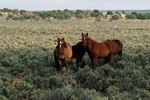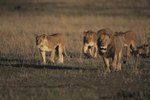
Hardy and aggressive, zebras are made to withstand searing heat and scorching drought. When zebra foals are born into this harsh environment, their parents and herd members defend them from predators and occasionally, from each other. Surviving to adulthood is a challenge for zebras, and every herd member is responsible for a foal's defense.
Sleeping in Shifts
While gathering in great numbers on the savanna, zebras sleep in shifts to keep watchful eyes on their surroundings. With eyes positioned on the sides of their heads, they are able to see above tall grasses, even while grazing. For the first few weeks of life, a zebra foal will remain close to his mother's side when awake and asleep for her protection, according to the University of Michigan's Museum of Zoology. Zebra mares are both protective and possessive of their foals, particularly when newly born, often threatening family members if they stray too close to the newcomer. Zebras have excellent eyesight day and night, and they take turns resting to allow herd members to scan the horizon for anything unusual, such as a predator. Any sign of trouble has the herd on the run, including the foals.
Camouflage
Zebras are preyed upon by predators such as lions, hyenas, wild dogs, cheetahs and leopards. The zebra's stripes act as camouflage against the savanna's tall grasses. Because predators are colorblind, they may see a large mass of movement instead of a single animal, according to the Animal Planet website. As large groups of zebras travel together, their stripes blend in with those of their neighbors, further adding to their predator's confusion. Mares with the youngest foals run first, according to the website Africa Wildlife Detective. Foals are able to run an hour after birth and are kept close by their mother's side when in flight. Stallions, positioned at the rear of the herd, are responsible for defending the group and reprimanding any stragglers.
Herd Instinct
Zebras live and travel in social groups of up to seven adult animals. One stallion and up to six zebra mares form each family unit. Within their families, the zebras establish a pecking order, with the most dominant, aggressive females gaining first priority at watering holes and shady spots. Mares with newborn foals isolate themselves a short distance from their families so their foals can learn to recognize their mothers' stripe patterns, according to the San Diego Zoo website. Family groups may join with others to create large herds, particularly during the rainy season or during a drought, but they stay together within the crowd, keeping the foals close by. During the breeding season, family groups go their separate ways.
Flight or Fight
While the zebra's first choice may be to flee from danger with the foal alongside, this may not always be possible. When zebras are cornered, they may defend their young with powerful kicks that can incapacitate a predator. A mare that is not the foal's mother may help to protect it if it should become separated from its parent. Family groups will come to the defense of a wounded animal, according to National Geographic, and form a protective circle around the victim while driving the predator off.
References
Photo Credits
-
Comstock/Comstock/Getty Images




